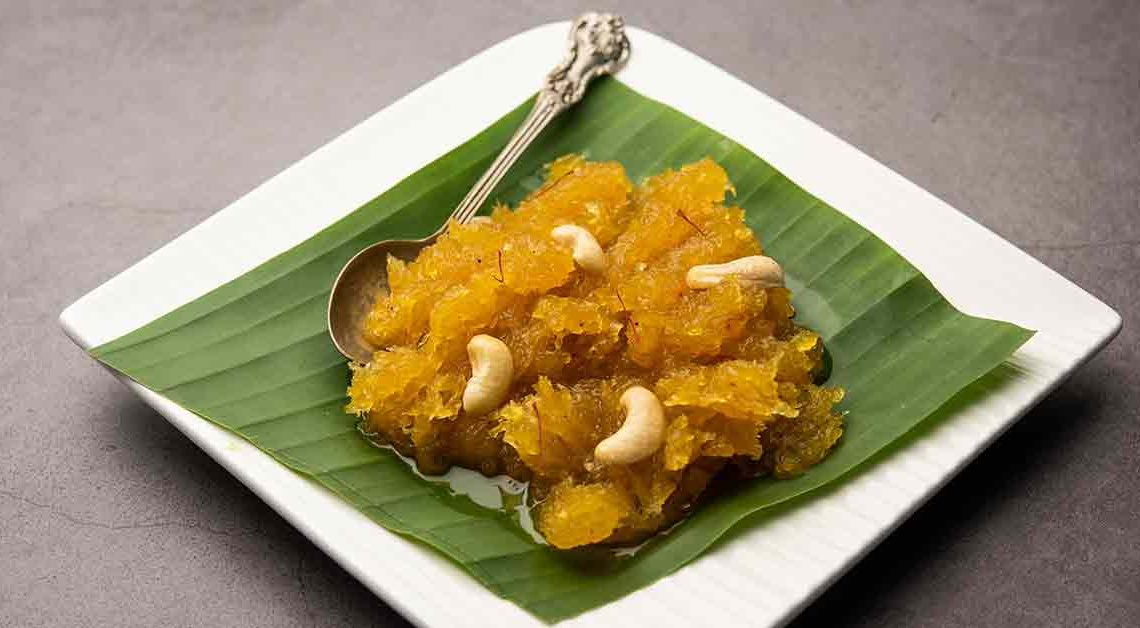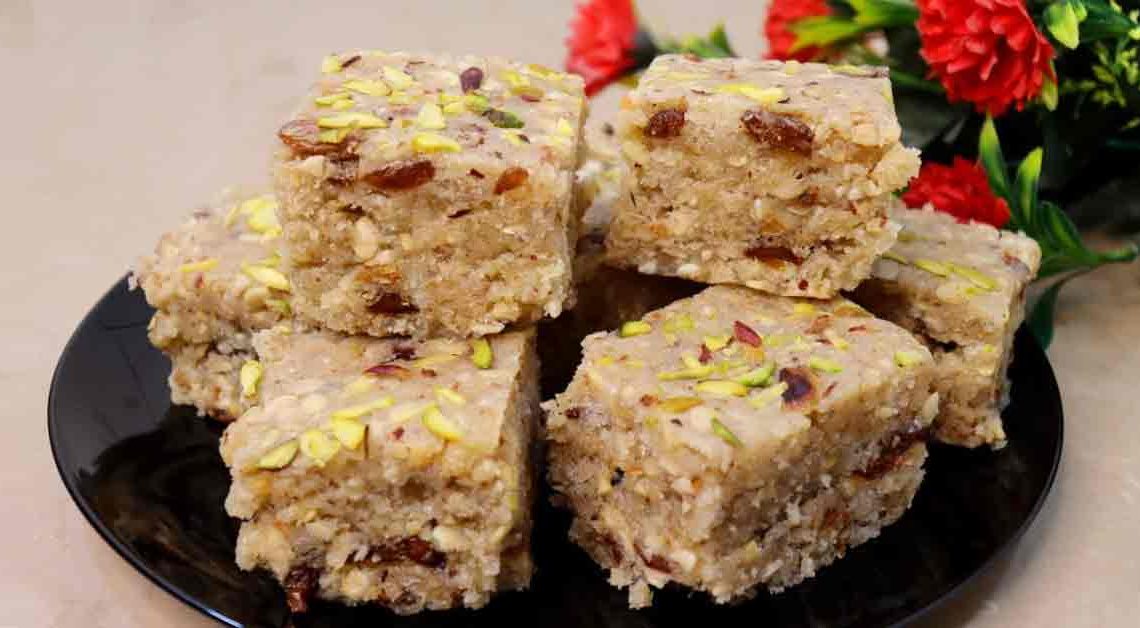Unraveling the Sweet Mystique of Kashi Halwa

Indulge your senses in a symphony of flavors, aromas, and traditions as we embark on a culinary journey on Mithainama that leads us to the heart of Indian cuisine. In a land where food is synonymous with love, we explore a timeless treasure that has been captivating taste buds for generations – the enchanting Kashi Halwa.
Picture this: golden-brown, silky threads of ghee-infused wheat flour, laced with fragrant cardamom and adorned with glistening, jewel-like raisins and almonds. Kashi Halwa, also known as Ashoka Halwa, is a sweet delight with a history as rich as its flavor. It’s a dessert fit for celebrations, and its lore stretches back to the ancient city of Varanasi, or Kashi, where it first gained its renown.
Join us as we dive deep into the vibrant world of Kashi Halwa, uncovering the secrets of its origin, its cultural significance, and, most importantly, savoring every sweet bite. Discover the magic of Kashi Halwa through our blog, and let it sweep you off your feet into a world of culinary enchantment.
Origin of Kashi Halwa
Kashi Halwa, also known as Ashoka Halwa, traces its origin to the ancient city of Varanasi, also known as Kashi, in northern India. This delightful sweet dish has a rich historical and cultural significance.
The city of Varanasi, one of the oldest continuously inhabited cities in the world, has a deep-rooted connection to Hinduism and is considered a sacred place. It is believed to have been created as an offering to deities during religious rituals and ceremonies in Varanasi.
The dish’s popularity gradually spread beyond Varanasi, and today, it can be found in various parts of India, with regional variations in ingredients and preparation methods. Its rich history, deep cultural roots, and its irresistible taste have made it a cherished dessert enjoyed by people across the country and beyond.
History of Kashi Halwa
Kashi Halwa, an iconic Indian sweet, carries a history as rich and diverse as its flavor. Its roots can be traced back to the ancient city of Varanasi, also known as Kashi, in the northern state of Uttar Pradesh, India.
Kashi, a city steeped in tradition and spirituality, has long been a hub of cultural and culinary heritage. Kashi Halwa, originally called Ashoka Halwa, is said to have been created centuries ago in the sacred kitchens of Varanasi’s temples. It was initially prepared as a divine offering during religious ceremonies and festivals, symbolizing the city’s devotion to its deities.
Over time, it transcended religious roots and became an integral part of everyday cuisine in Varanasi. The locals, known for their warm hospitality, began serving it to guests as a symbol of affection and welcome. The dish’s fame spread beyond Varanasi‘s borders, and it soon found its place in the diverse tapestry of Indian sweets, adapted and customized in various regions.
Cultural Significance
Kashi Halwa, also known as Ashoka Halwa, holds significant cultural importance in India, particularly in the region of Varanasi (Kashi) where it originated. Its cultural significance is intertwined with various aspects of Indian life and traditions:
Religious Rituals and Offerings: It has deep connections with religious ceremonies and offerings in Varanasi, a city considered one of the holiest in Hinduism. It is often prepared as a prasad during pujas in temples and at religious festivals. It symbolizes devotion and is believed to please the deities.
Hospitality: In Varanasi and many other parts of India, offering to guests is a gesture of warmth and hospitality. It’s a way of showing affection and respect to visitors, reflecting the traditional Indian value of treating guests as embodiments of the divine.
Festivals and Celebrations: It is a common sweet prepared during festivals and special occasions. It adds a touch of sweetness to celebrations, whether it’s Diwali, weddings, or other significant life events. Its presence signifies the joy and auspiciousness of the occasion.
Where is Kashi Halwa Famous?
Kashi Halwa, also known as Ashoka Halwa, is particularly famous and enjoyed in various parts of India, with its roots in the city of Varanasi (Kashi). While it originated in Varanasi, it has gained popularity and recognition throughout the country. Here are some places where it is especially famous:
Varanasi (Kashi): As the birthplace of Kashi Halwa, Varanasi in the northern state of Uttar Pradesh is where the sweet dish holds the most significance. It is an integral part of the local culture, often prepared as a sacred offering in temples and served to guests as a symbol of hospitality.
Uttar Pradesh: It is widely popular throughout the state of Uttar Pradesh, where Varanasi is located. It’s a common sweet prepared during festivals, weddings, and other special occasions. Each region in Uttar Pradesh may have its own variations and methods of preparing the dish.
South India: It has made its way to South India, where it is known as Ashoka Halwa. It’s particularly famous in the states of Tamil Nadu and Karnataka, where it has been adapted and is often served in sweet shops and as a dessert at weddings and other events.
Interesting Facts and Trivia
Kashi Halwa, a delectable Indian sweet with a rich history, is full of interesting facts and trivia. Here are some fascinating tidbits related to this beloved dessert:
- It is often prepared as a prasad (offering to deities) during pujas (rituals) in temples. It is believed to please the gods and symbolizes devotion and purity.
- In Varanasi and many other parts of India, offering to guests is a symbol of warmth and hospitality. It reflects the traditional Indian value of treating guests as embodiments of the divine.
- While the original Kashi Halwa recipe is made with wheat flour, ghee, and sugar, different regions of India have put their own twists on it. For example, in South India, it is known as Ashoka Halwa and is made with moong dal (split mung beans) or semolina.
- Diwali, the Festival of Lights, is a time when it is in high demand. Families prepare and share this sweet treat during the festival, making it an integral part of Diwali celebrations.
- It is often garnished with raisins, cashews, and almonds. These toppings not only add a delightful crunch but also enhance its visual appeal.
Did You Know?
Did you know that Kashi Halwa, the beloved Indian sweet, not only delights the taste buds but also offers a range of health benefits?
- It is made from wheat flour, which is a good source of essential nutrients, including carbohydrates, proteins, and dietary fiber. It provides energy and a sense of fullness.
- The generous use of ghee in it not only enhances its flavor but also offers healthy fats that can be easily digested. Ghee contains vitamins A, E, and K, and it is believed to be good for the digestive system.
- In some variations of Kashi Halwa, especially in South India, it’s made using moong dal halwa. This adds a protein punch to the dessert, making it a nourishing and satisfying treat.
- It is often flavored with cardamom, which is not just for taste but also for its potential health benefits. Cardamom is known to aid digestion, improve circulation, and provide relief from respiratory issues.
- The addition of dry fruits like raisins, cashews, and almonds provides antioxidants, which help combat free radicals and may contribute to overall well-being.







